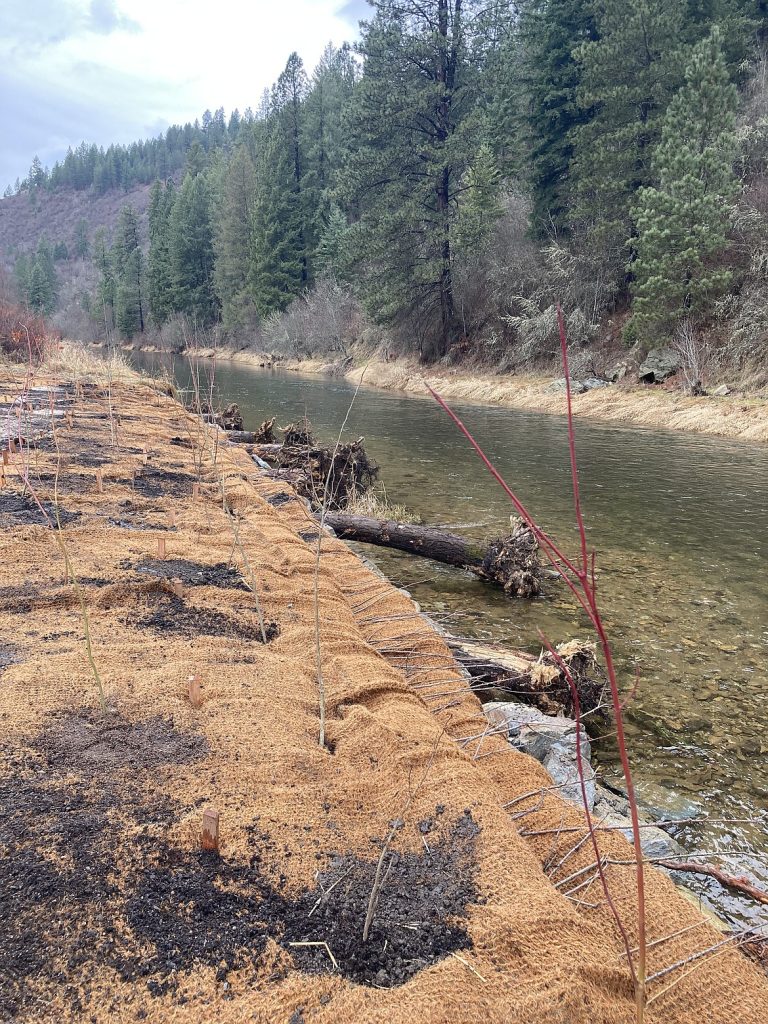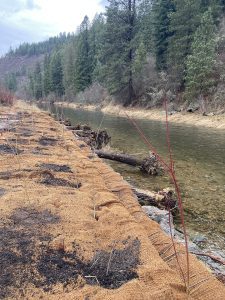Month: July 2025
THE DIRT: Understanding Permits for Working Near Water in the Coeur d’Alene Basin

Working near water in the Coeur d’Alene Basin often requires obtaining one or more permits, particularly when wetlands are involved. These permits ensure that restoration, construction or development activities are carried out responsibly to protect aquatic ecosystems, water quality and public resources. This article gives a summary of key permits commonly required, with a focus on activities affecting wetlands.
Wetland-related activities: Section 404 and 401 Permits
A critical permit for projects impacting wetlands, or any Waters of the United States, is the Section 404 Permit, administered by the U.S. Army Corps of Engineers (ACOE). This permit is required when dredged or fill material is discharged into rivers, lakes, streams or wetlands. Wetlands are considered protected due to their essential roles in water filtration, flood control and habitat provision.
A Section 404 Permit typically includes conditions from a 401 Water Quality Certification, issued by the Idaho Department of Environmental Quality (DEQ), Coeur d’Alene Tribe or EPA, depending on the project’s location. This certification ensures that the proposed activity complies with state or tribal water quality standards.
Application for these permits is streamlined through a Joint Application Form (between Idaho Department of Lands (IDL), Idaho Department of Water Resources (IDWR), and ACOE), which covers multiple regulatory requirements. Fees vary. General (Nationwide) permits are often free, while individual permits may cost $10–$100.
Other permits for working near water
· Idaho Stream Channel Alteration Permit: Required for any activity that alters the shape, direction, or flow of a stream. This applies to material removal or placement within the high-water mark. Issued by the Idaho Department of Water Resources (IDWR), the permit costs $20.
· Encroachment Permits: These are necessary for structures such as docks, pilings and bank stabilization along navigable waters, including Lake Coeur d’Alene and its rivers. Issued by the IDL, IDWR or the Coeur d’Alene Tribe (for projects within reservation boundaries including dredge and/or fill), these permits may also be obtained through the Joint Application Form between IDL, IDWR and ACOE.
· Floodplain Development Permits: In areas like Shoshone and Kootenai counties, work in designated floodplains requires a local permit to ensure compatibility with flood management standards. FEMA No-Rise Certifications may be required for any project in a floodway and must be reviewed to determine if the project will increase flood heights. An engineering analysis must be conducted before a permit can be issued. The community’s permit file must have a record of the results of this analysis, which can be in the form of a No-Rise Certification. This No-Rise Certification must be supported by technical data and signed by a registered professional engineer. The supporting technical data should be based on the standard step-backwater computer model used to develop the 100-year floodway shown on the Flood Insurance Rate Map (FIRM) or Flood Boundary and Floodway Map (FBFM).
· Site Disturbance Permits: Counties such as Kootenai and Benewah may require these for grading, excavation or drainage work to protect against erosion and sedimentation. Shoshone County also requires Site Disturbance permits for waterfront and upland disturbance projects, which are typically considered high-risk and require a professional design plan. For areas within the Bunker Hill Superfund Site, an Institutional Controls Permit is also required. These permits are free of charge.
· Construction General Permit: Required for projects disturbing over 1 acre of land and discharging stormwater to U.S. waters. Managed by EPA and DEQ, it involves preparing a Stormwater Pollution Prevention Plan (SWPPP) and submitting a Notice of Intent. SWPPP’s must be displayed on the project site and visible for inspection throughout the life of the project.
· Water Rights Permits: Required for temporary or permanent diversion or impoundment of surface or groundwater. Managed by IDWR, these permits ensure legal use and sustainable water allocation. This permit is required for pulling water from area waterbodies for irrigation and drilling wells for domestic water use.
These permits are not just bureaucratic requirements; they play a crucial role in protecting water resources, especially in sensitive areas like wetlands. Applicants are encouraged to coordinate with the appropriate agencies early in project planning to ensure compliance and avoid costly delays, fines or other penalties.
THE DIRT: Waterfront properties

Idaho waters, including rivers, lakes, and streams, are designated as state property, which is meant to be enjoyed by all and is therefore protected under state and federal regulations, including the Clean Water Act. Owning, leasing, and enjoying waterfront property is a special privilege in North Idaho, but with this privilege also comes key responsibilities. Protecting your property is important, but protecting the water itself is equally important. Construction activities in and around water bodies require permits. These permits ensure construction projects or alterations are completed in a manner that will protect water quality, the environment, and aquatic species such as fish and their spawning habitats. If work is performed without the necessary permits, it can result in profound consequences, including costly fines and extremely expensive restoration work. Violations are taken very seriously, and in recent years, several local landowners have learned this hard lesson. Each individual landowner was fined thousands of dollars for failing to obtain permits and violating sections of the Clean Water Act. In addition to fines, each property owner also had to perform expensive restoration work that required hiring environmental engineers. When working around water bodies, it is in your best interest to follow all permitting procedures and requirements.
Protecting water quality is important everywhere, but has even more importance when working along water bodies within the Bunker Hill Superfund Site. Sediments found in and along most local waterways contain hazardous levels of heavy metals, including lead and arsenic. Introducing contaminated sediments into waterways when performing construction activities can be even more damaging to the environment and poses a threat to wildlife and humans. Contaminated sediments from historic mining practices have accumulated along area banks and shores for over one hundred years, altering the nature of our banks, shores, and waterways. These sediments are highly erodible and make riverbanks and lake edges much less stable. These issues often lead to owners performing erosion control and bank stabilization projects to protect their land. Before beginning any of these types of projects, make sure to contact the correct agencies. The health and beauty of our waterways depend on us all doing our part.
When it comes to protecting North Idaho’s water resources, awareness and responsibility go hand in hand, especially in areas like the Bunker Hill Superfund Site, where risks are elevated. Understanding the importance of permits is the first step. But what exactly are the permits you might need, and how do they apply when working near rivers, lakes, or wetlands?
To dive deeper into the specific permits required—particularly when wetlands are involved—read our next article, which will discuss working permits for construction sites near water inside the Coeur d’Alene Basin.
The Dirt is a series of informative articles focused on all aspects of cleanup efforts associated with the Bunker Hill Superfund Site. Our goal is to promote community awareness of contamination issues, to provide tools for protecting public health, and to keep the community informed of current and future cleanup projects. The Dirt is a group of committed and local experts from multiple agencies, including the Basin Environmental Improvement Project Commission, Panhandle Health District, Shoshone County, Silver Valley Economic Development Corporation, and the Idaho Department of Environmental Quality.
Related Articles

THE DIRT: The history of roads in the Silver Valley
Read Full Article
